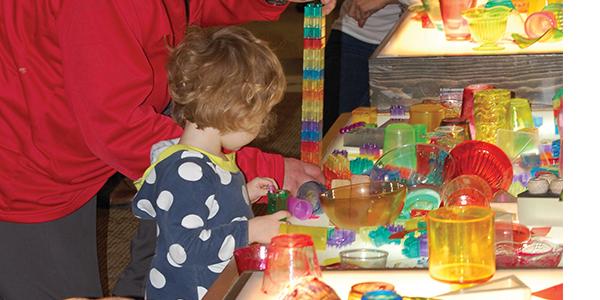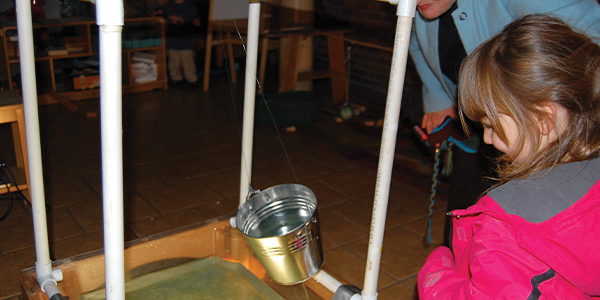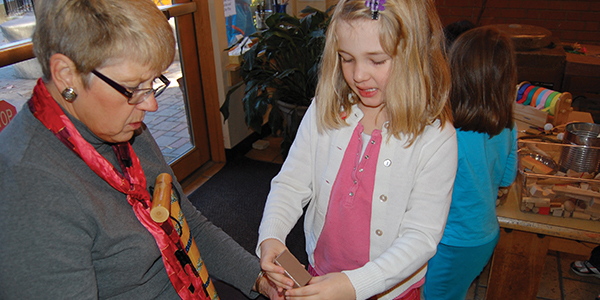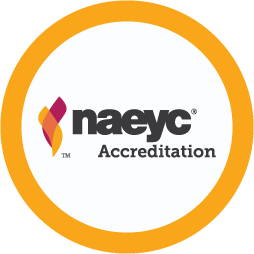Engage Children’s Communities with Friends and Family Day!

You are here
In the late 1990s, before the days of digital cameras, classroom websites, or smartphones, our early childhood center offered families handwritten daily journals of classroom learning experiences. Our teachers and children used whiteboards to tell the day’s story in words and drawings. In one classroom, the educators and children included a written snippet related to each child, every day, and displayed them for parents and caregivers to review during pickup time.
One day, a graduate student from Japan who had a child enrolled in our program stood in front of the whiteboard, snapped a photo of the day’s recollections, and sent it off to extended family and friends back home in Japan. As the family continued taking and sharing photos over the school year, our thinking about making daily connections between children’s worlds of home and school was transformed.
Together, we wondered, what would happen if we widened our circles and broadened our sense of family relationships in the school? How might we rethink children’s learning in this community context? This line of thinking led to one approach that has been particularly valuable: our annual Friends and Family Day.
To prepare for Friends and Family Day, teachers and children together reflect on their daily classroom experiences to design ways to engage guests in their learning. At the events, guests are welcomed with coffee, tea, and baked goods from the school’s kitchen. They choose between touring the school or going directly into the classrooms and shared spaces to engage in projects with the children.

Making connections through big ideas
Our program offers a lot of flexibility for teachers to create playful, challenging, and engaging curriculum with children. Teachers observe children and plan carefully to provoke, enhance, extend, and document their learning. As part of this approach, we have embraced the study of “big ideas,” influenced by the work of Dr. Christine Chaillé, as one way we learn together and engage families more fully. When we focus on a big idea together, we begin to see elements of it everywhere. We discover that seemingly unrelated projects are actually connected.
Recently, we studied movement and motion as a big idea. As we explored the many aspects of motion—speed, trajectory, gravity, and so on—we began to see common elements of motion in our daily experiences. Early in the motion study, teachers created a space in a long hallway for children to build ramps, chutes, and pathways for balls. Teachers observed, took photos and videos, and noted children’s interests to continue to build on their exploration and experiences.
This year, we purposefully documented the children’s learning experiences with motion to create a gallery showcasing and explaining those experiences in preparation for Friends and Family Day. This documentation served as the foundation for the collaborative learning that children, family, and friends engaged in throughout the event. We saw that viewing the children’s prior learning put power in the hands of family and friends. They asked more substantive questions about the children’s thinking about movement and motion—and about everyday school experiences.
Learning together: Friends and Family Day
Our approach to learning is new to most families when they become members of our school community. We want families to see how we interact with their children and model our view of children as idea generators, concept builders, and collaborators. During Friends and Family Day, the activities and materials used to recreate and build upon the ideas and activities that the children experience in their classrooms and studios. Activities are organized so that both children and adults have full access to the materials. We encourage family and friends to work alongside children, experimenting with the materials, and we give adults clipboards and pens so they can document the theories that children and adults develop together. We ask family and friends, “What do you see and hear? What surprised you?”
As we explored movement and motion, our center’s piazza was filled with children and adults absorbed in learning together. They created sand art using child-made pendulums; they experimented with the properties of water by making boats out of reused plastic, metal, and wooden materials; they built block towers together and then considered how to use a wrecking ball to topple the towers. We observed children, families, and friends interacting with the materials and making adjustments to improve their designs.

The following vignettes, developed from our observation notes during Friends and Family Day, show how everyone benefits from this deep involvement in the children’s learning.
As Nora, age 4, and her grandmother approach the water bucket pendulum, a studio teacher asks, “Nora, will you show your grandma how you get this to work?” Nora begins to fill the bucket with water and gently pushes it as the water slowly trickles out the hole in the bottom of the bucket. Nora says, “This is like the red swing we have at home. It moves the same way.” Her grandma responds, “I noticed wherever we start it, it goes back to the same place.” Nora adds, “It’s coming right back home!”
Henry, age 3, takes his uncle by the hand and leads him to the wooden ramps and balls in the corridor. “Look,” he says, “You can make it go fast!” He shows his uncle how to prop the ramp-up to make a steeper incline for the balls. He tells his uncle to “shoot it all the way down the hallway!” His uncle follows his lead, dropping the ball onto the ramp, and they both cheer with enthusiasm as it rolls down the hall. They repeat this experiment many times as friends watch.
At the water table, Chloe’s grandmother gently holds a stack of scrap wood and cork as her grandchild tapes it together. Chloe, age 4, explains, “I’m going to stick these really hard together so they will float. If you don’t stick them really hard the tape won’t stick.” Her grandma asks, “So what did you discover?” Chloe responds, “The wood is too heavy. I need fabric and string.”
Tips for Planning a Friends and Family Day
- Engage children in setup and design of curriculum events.
- Encourage active participation by people of all ages by varying the height of tables, platforms, and activity placement. Put materials and project components on floors, raised platforms, low tables, and high (adult-sized) tables. Spread adult-sized chairs throughout so visitors with limited mobility can fully participate.
- Consider project components and materials carefully. Are there any possible safety issues (e.g., choking hazards)? Do the projects offer a range of developmentally appropriate activities for multiple age levels?
- Rather than attempting to hold, dry, and return small and individual art pieces to families, engage participants in impermanent art constructions or consider creating a large cooperative drawing, mural, or other collaborative piece. You can take photos to capture the learning and help families remember the experiences.
- Plan for projects that model your program’s pedagogy through hands-on experiences. Post big, enduring questions—open-ended questions with many different possibilities that will linger in participant’s minds.
- Offer your guests healthy and nutritious snacks, and let them know on the invitation what to expect in terms of food so they can plan ahead.
Sometimes, family and friends want to show the children what they think is the right way to interact with the project materials, such as how to move the pendulum or swing the wrecking ball. The studio teachers gently encourage the adults to instead invite the children to share their thinking and wonderings. Soon, there is a noticeable shift in adult-child interactions as the visitors model for each other the collaborative style that engages both child and adult. When we offer hands-on experiences, parents, extended family, and community members see children’s abilities to investigate, and they appreciate our approach to teaching and learning.
Read more about Friends and Family Day in the longer version of this article, “Engaging Friends and Family in Young Children’s Education,” in the September 2018 issue of Young Children.

STANDARDS 3: TEACHING; 7: FAMILIES
3F: Making Learning Meaningful for All Children
7A: Knowing and Understanding the Program's Families
Photographs: courtesy of the authors
Will Parnell, EdD, is a professor of early childhood education, department chair of curriculum and instruction, and a pedagogical liaison to the Helen Gordon Child Development Center at Portland State University, in Portland, Oregon. He currently serves as president-elect of the National Association of Early Childhood Teacher Educators. His most recent book is Meaning Making in Early Childhood Research: Pedagogies and the Personal.
Ellie Justice, MA, is the director of the Helen Gordon Child Development Center at Portland State University. She works to support young children and families in campus early childhood programs through collaboration with university faculty and students.
Laure Pearson Patrick, MS, is a studio teacher and preschool coordinator at Helen Gordon Child Development Center at Portland State University. Her work focuses on children ages 3 to 5.